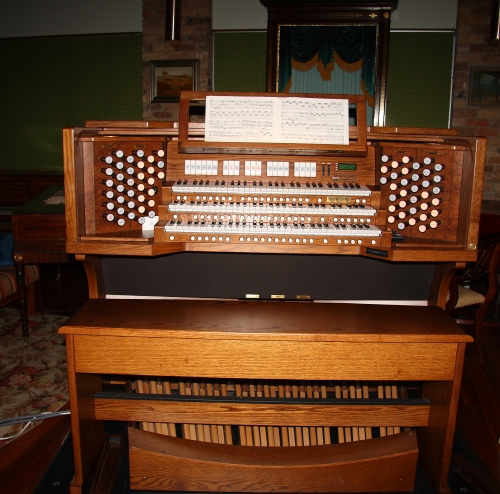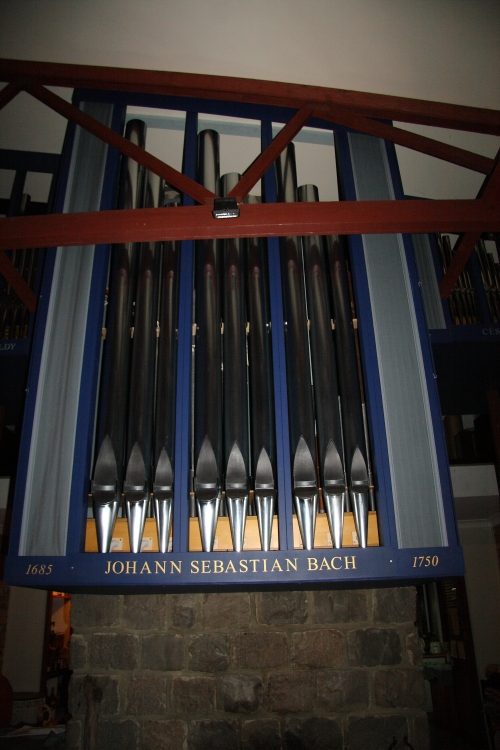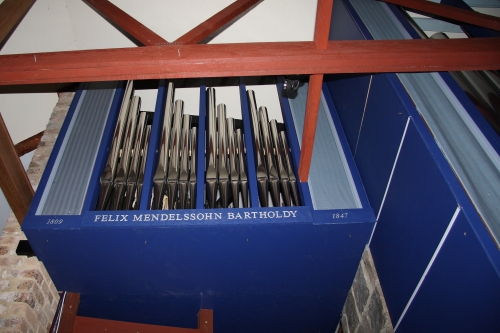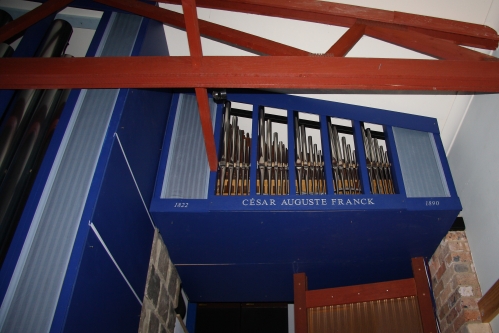This organ is a major technological breakthrough, combining a digital electronic instrument of 63 voices based on stops from some of the world’s greatest pipe organs, and a 23-stop conventional pipe organ. The digital component, by Ahlborn-Galanti, comprises four alternative complete organs, each based on a specific national style, eg. north European 18th century (J.S.Bach), French (Franck) and English (Mendelssohn) 19th century, and “American Classic” of the 20th Century (as exemplified by the work of Aeolian-Skinner), as well as a “default” voicing which the organist can vary at will.
The pipe organ, culmination of work by a number of Australian organ builders, most recently Brown Associates, around a “core” of pipework by Ronald Sharp, creator of the Sydney Opera House grand organ, is a tonal replica of a medium-sized church organ by Gottfried Silbermann (1683-1753), the East German builder most familiar to J.S.Bach (1685-1750). Both pipe and digital instruments may be used separately or together from a state-of-the-art moveable three-manual and pedal oak console by Ahlborn-Galanti.




The specification is as follows (pipe stops are indicated p):
(R jamb) (R jamb)
p bordun 16′ quintaton 16′
p prinzipal 8′ prinzipal 8′
holzprinzipal 8′ p gedackt 8′
p rohrflote 8′ quintadena 8′
p gedackt 8′ p oktav 4′
gamba 8′ p koppelflote 4′
p oktav 4′ p nazat 2 2/3′
p spitzflote 4′ p oktav 2′
quint 2 2/3′ p blockflote 2′
superoktav 2′ p terz 1 3/5′
p waldflote 2′ p klein nazat 1 1/3′
p mixtur III scharf III
kornett V krummhorn 8′
p trompete 8′ p vox humana 8′
klarine 4′ fest trompete 8′
SWELL PEDAL
(L jamb) (L jamb)
bourdon doux 16′ untersatz 32′
montre 8′ contraviolone 32′
flute 8′ prinzipal 16′
flute celeste 8′ p subbass 16′
viole de gambe 8′ violone 16′
voix celeste 8′ p oktav 8′
prestant 4′ p bassflote 8′
flute conique 4′ p choralbass 4′
octavin 2′ nachthorn 4′
cymbale III mixtur IV
plein jeu IV contrabombarde 32′
basson 16′ p posaune 16′
haurbois 8′ dulzian 16′
trompette 8′ trommet 8′
chalumeau 4′ schalmei 4′
Accessories:
- zymbelstern, glockenspiel, tympani
- tremulants to Swell and Choir/Positive
- superoctave, suboctave and unison off couplers to Swell and Choir/Positive
- Swell to Great, Chir/Positive to Great, Swell to Choir/Positive, Swell to Pedal, Great to Pedal, Choir/Positive to Pedal couplers
- interactive stop lists: pipe only, digital only, pipe plus digital
- combination pistons: 20 general, 8 divisional to each manual, 4 divisional to Pedal
- balanced expression pedals to Swell and Choir/Positive, general crescendo pedal
- automatic transposition by semitonal step
- tracker touch to manuals
- reverberation and general loudness correction for room acoustic
- selection of termperaments: meantone, equal, Werckmeister, Kirnberger, Neidhardt, Vallotti, d’Alembert, Kellner
- direct electric stop and key action
Pipe voicing and tuning: Ian and Jenny Brown
Electronic voicing and preparation: Ian Sell
Chest construction and pipe refurbishment: Mark Fisher
Frame and case construction: Tony Brebner
The instrument is extremely versatile, and has been used in concerts in a wide range of music from Bach to the virtuoso 19th centure oragns works of Liszt, Rheinberger, Reubke, Franck and Guilmant.
Concert Use:
M.Brimer : 05.07.09
M.Brimer : 06.06.10
M.Brimer : 05.06.11
M.Brimer : 01.07.12
M.Brimer : 18.03.13
M.Brimer : 11.05.14
M.Brimer : 02.08.15
M.Brimer : 05.06.16
M.Brimer : 23.07.17